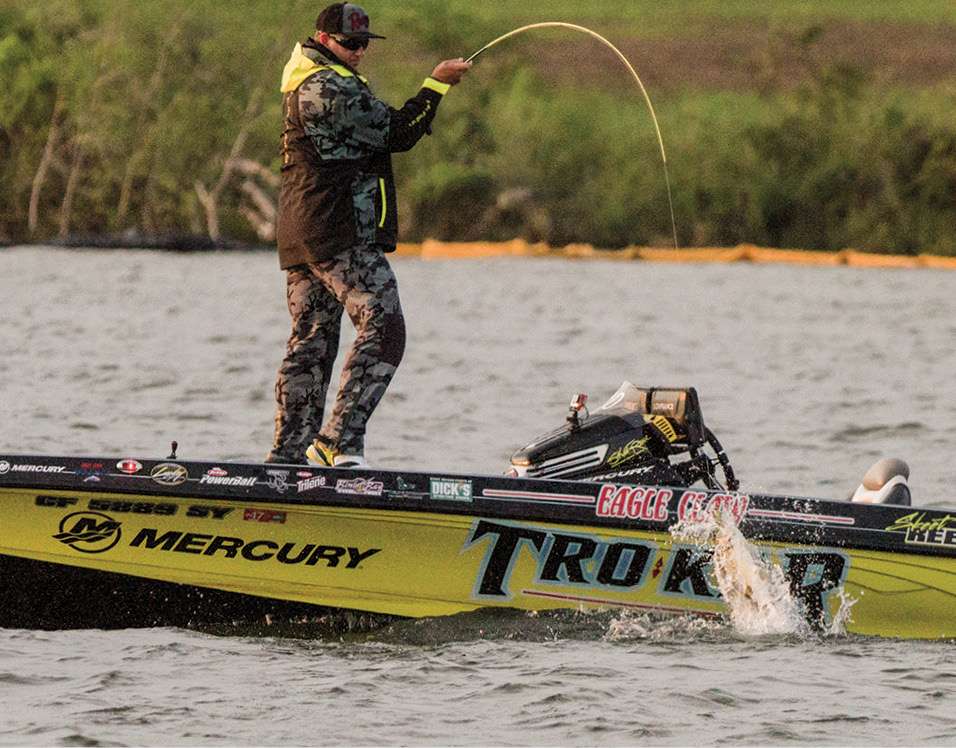
In early 2007, the Basstrix paddletail swimbait was the Cabbage Patch doll of the fishing world, the most popular and hardest-to-get product around. If only the craze had overlapped with Black Friday, surely there would’ve been some unhappy bass clubbers trampled in a mad stampede to get the last pack.
At one point, the madness over the hollow-bellied lure got so intense that one online retailer essentially had the hand-painted plastics sold out before they arrived, and even then limited each customer to just a few packs in order to preclude an eBay free-for-all.
The Basstrix seemed so revolutionary that Texas pro Kelly Jordon told Bassmaster’s Louie Stout, “It’s so good that some guys think it will make the spinnerbait obsolete.”
While the lure was developed by Southern California’s Bruce Porter, the angler who truly popularized it nationwide was Alabama pro Steve Kennedy. He caught 122-14 at an Elite Series event on Clear Lake to set what was then a B.A.S.S. record four-day weight total, and he did it with a variety of swimbaits, including the Basstrix. He spent a few thousand bucks on swimbaits upon his arrival, a few thousand more before he left, and at least in the low four figures of that on Basstrix alone. He continued to use the lure in the short term, but now he can’t remember the last time he tried one.
“I don’t throw them,” he said. “The ones I bought back then had a lot of softener in them to make them good. But after a while, they harden up. Today I don’t carry them in the boat with me.”
Despite moving away from the Basstrix — he said when inspired to throw a soft-bodied swimbait these days he tends to reach for a solid-bodied, ribbed Keitech or something of that ilk — Kennedy doesn’t deny that they do things that other lures don’t. “When they’re swimming right, it’s like the whole body is swimming, not just the tail. I’m an engineer, and it’s what I’d call a natural frequency. The problem is that they’re hand poured and not consistent. Only like one out of three would be OK and one out of 10 would be good.”
While the major hubbub dissipated over the ensuing years, the effectiveness of the Basstrix still moved sales, as evidenced by the emergence of similar products, including the Yum Money Minnow, Strike King Shadalicious and Zoom Swimmer. So why didn’t it continue to play a huge role in tournaments? Kennedy suspected that part of it was that the Elite Series has a limited number of events “and several of those are usually very similar. Clear Lake was a clear water, prespawn event.” Then he added that “all highly effective new baits go through a similar cycle with the bass getting conditioned to it and similar options from other companies.”
While the Basstrix may have ceded some of the limelight, as Kennedy recognized, it never fully went away. Skeet Reese agreed. “All hollow bellies still catch fish like crazy,” he said. “It’s just that the Keitech has been the hot bait. Paddle tails have way more action than all of the other soft swimbaits. It’s not just tail movement; it’s the whole body.”
He should know, because the most recent of his eight B.A.S.S. victories came expressly because he picked up the Basstrix. It occurred at Guntersville in April 2015, and unlike Kennedy, who relied mostly on the 6-inch version, Reese used the longer and bulkier 7-inch model. After the completion of the majority of an unproductive practice period, Reese was given a tip to try the Basstrix by his friend Byron Velvick. Before Kennedy’s 2007 win convinced anglers nationwide that swimbaits were a viable tournament option, Velvick had prepared a prologue to that story with his own swimbait win in the 2000 Western Invitational on Clear Lake.
“Those fish feed a lot on gizzard shad,” Reese said of the bass at Guntersville. “That was the bait that represented the forage the best. To a 5- to 7-pound fish, a 7-inch bait is just a Scooby snack.”
Reese said that the one advantage of the Basstrix-style lures is that they can be rigged weedless on a weighted hook. At Guntersville, he used a 7/0 Lazer TroKar, which allowed him to pull the lure slowly through thick laydowns. “It has a great hookup ratio,” he added. “And you can still bring it through milfoil, hydrilla and reeds.”
At Guntersville, he used a slow rate of retrieve, and that’s his default during the prespawn through the immediate postspawn periods. He’ll continue to use the lure in the shad spawn or for summertime schooling fish, but then it gets a little added speed. These lures have also proved deadly on offshore ledges and humps, where a heavy jighead gets the call. Just make sure the hook has plenty of gap to get around all of that balled-up plastic.
The original Basstrix is now available in sizes from 3 1/2 to 8 inches and a wide variety of colors. Reese says he relies most heavily on chartreuse shad, ayu, blue/chartreuse and threadfin shad, although he’ll substitute something that looks like a golden shiner when fishing in Florida. While the 5- and 6-inch sizes are most anglers’ defaults, he doesn’t hesitate to go larger anytime he’s confident in the potential of a 4-plus-pound bite. With the bigger ones, he’ll use his 7-foot, 6-inch Wright & McGill Skeet Pro Carbon Swimbait rod paired with 20- or 25-pound-test Trilene 100 Percent Fluorocarbon. He’s thrilled that TroKar has developed 7/0 and 9/0 swimbait hooks in 3/4- and 1-ounce versions. “They’re weedless, so you can slow roll them 15 or 20 feet deep through a brushpile,” he said. With the more conventionally sized swimbaits, he employs his signature 7-foot, 6-inch swimbait/Carolina rig rod, usually with 20-pound Trilene 100 Percent Fluorocarbon. In either case, he uses the Skeet Victory reel with a 6.3:1 gear ratio.
“When they want it, there’s no second guessing if you got bit; they crush it,” he said. “Under the right conditions, there’s no such thing as a delayed hook set. You just crack ’em.” On those occasions when the fish are just nipping at the tails, or swiping and missing, there’s usually a reason. He’ll experiment first with color, then with size, then with speed. If none of those makes a difference, and he’s still convinced that the swimbait is the proper tool, he’ll try something other than the Basstrix. He especially likes the discontinued Berkley Hollow Belly, as well as the hyper-realistic Sick Fish. The latter, he said, “has a solid body, but the same vibrating, undulating action.”
While Kennedy is certainly right that all new phenoms of the tackle world eventually cool off, the characteristics that made them great never die completely. The Senko and the ChatterBait may never be as effective on pressured lakes as they were the first time around, but they’ll continue to be valuable tournament tools, and so will the Basstrix and its ilk. Even Kennedy, who admits that he never got around to buying the 7-inch versions, believes that under some conditions, it can’t be topped.
“If you’ve got a Basstrix that swims right, it won’t last five minutes,” he said. “I don’t care what lake you’re on.”






